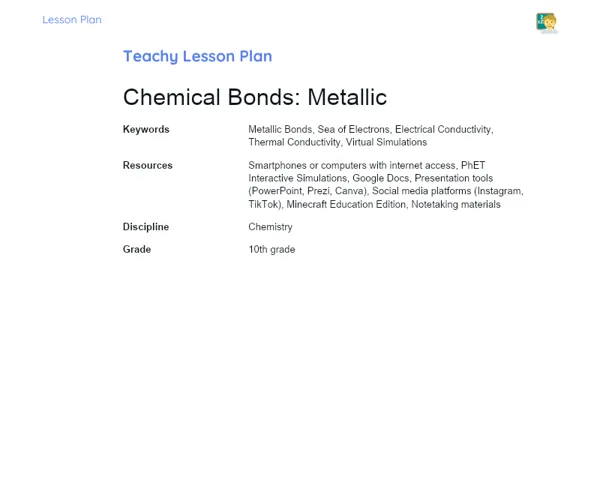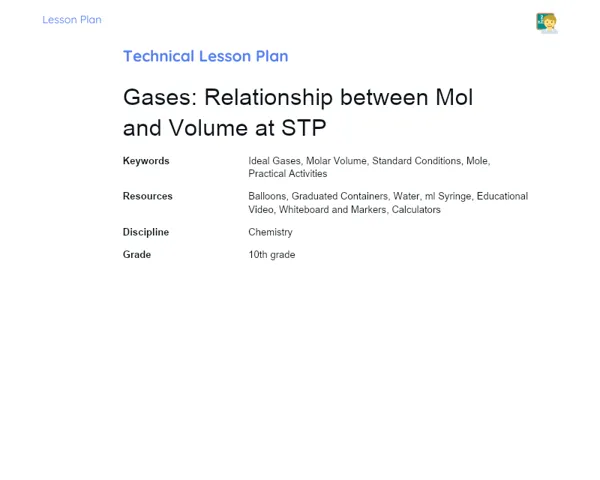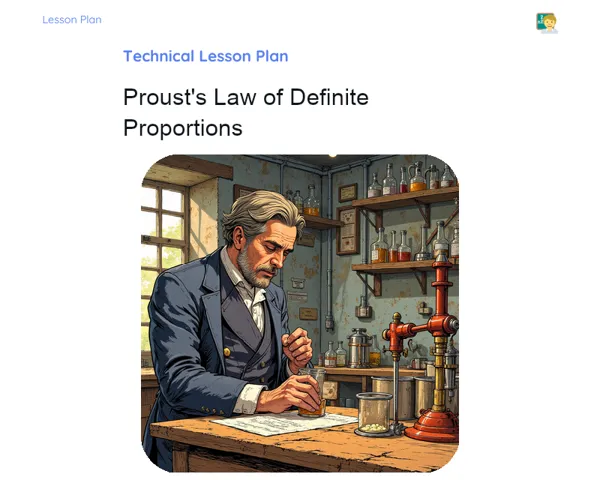Lesson Plan | Socioemotional Learning | Electrochemistry: Introduction
| Keywords | Electrochemistry, Electrochemical Cell, Redox Reactions, Movement of Electrons, Anode, Cathode, Socioemotional Methodology, RULER, Self-awareness, Self-control, Responsible Decision Making, Social Skills, Social Awareness, Mindfulness, Hands-on Activity, Reflection, Emotional Regulation |
| Resources | Copper coins, Zinc nails, Lemons, Copper wires, Small LED bulbs, Multimeters, Paper and pens for reflections, Whiteboard and markers |
| Codes | - |
| Grade | 11th grade |
| Discipline | Chemistry |
Objective
Duration: (10 - 15 minutes)
The aim of this segment in the Socioemotional Lesson Plan is to introduce the basic concepts of electrochemistry in a clear and structured way, helping students grasp initial ideas about redox reactions and how a battery works. Understanding these fundamentals will prepare students to explore their practical applications in day-to-day life. Additionally, this phase helps students develop socioemotional skills such as scientific curiosity, problem-solving, and teamwork, which are vital for their holistic development.
Objective Utama
1. Understand what a battery is and how redox reactions function.
2. Comprehend the movement of electrons and electric current, recognizing that materials can either be consumed or deposited.
3. Identify the anode and cathode in an electrochemical cell.
Introduction
Duration: (15 - 20 minutes)
Emotional Warmup Activity
Mindfulness Breathing for Focus
The warm-up activity will involve a Mindfulness exercise focused on breathing, aiding students to concentrate on the present and mentally gear up for the lesson.
1. Ask students to sit comfortably in their chairs, feet flat on the floor and hands resting on their thighs.
2. Guide students to gently close their eyes or, if they wish, maintain a soft gaze at a fixed point in front of them.
3. Encourage them to start focusing on their breathing, feeling the air move in and out through their nostrils, acknowledging the natural rhythm of their breath without trying to change it.
4. After a few moments, prompt them to take a deep breath in, filling their lungs fully, and then exhale slowly and steadily.
5. Continue prompting students through a few deep breaths, urging them to concentrate solely on the act of breathing, putting aside any other thoughts or distractions.
6. After about 5 minutes, invite students to gently shift their focus back to the classroom, slowly opening their eyes and getting ready for the next activity.
Content Contextualization
Electrochemistry touches various aspects of our daily lives, from the batteries that power our gadgets to industrial processes like galvanization and metal production. Understanding redox reactions and electron movement is vital not just for chemistry, but many other fields like engineering and medicine. By delving into these concepts, students will appreciate the real-world applications of theory and cultivate a deeper respect for the science and technology they encounter daily. Moreover, this understanding can inspire a sense of responsibility and social awareness, prompting students to consider the environmental and ethical aspects of electrochemical technologies.
Development
Duration: (60 - 75 minutes)
Theory Guide
Duration: (20 - 25 minutes)
1. Main Components of Electrochemistry
2. Definition of Electrochemical Cell: A battery is a device that transforms chemical energy into electrical energy via redox reactions. Common examples include AA batteries, AAA batteries, and lithium-ion batteries.
3. Redox Reactions: These are reactions where electrons are transferred between reactants. The oxidizing agent gains electrons (is reduced), while the reducing agent loses electrons (is oxidized).
4. Movement of Electrons: Within a battery, electrons travel from the anode (where oxidation happens) to the cathode (where reduction occurs) through an external circuit, generating electric current.
5. Anode and Cathode: The anode is the electrode where oxidation occurs, and the cathode is where reduction takes place. A classic case is the Daniell battery, comprised of a zinc anode and a copper cathode.
6. Electrolytic Solution: This is a solution capable of conducting electricity due to ions' presence. In a battery, the electrolytic solution facilitates the movement of ions between electrodes, completing the internal circuit.
7. Practical Example: Daniell Battery - The zinc anode is submerged in zinc sulfate solution (ZnSO4) while the copper cathode is placed in copper sulfate solution (CuSO4). Electrons flow from zinc to copper through the external circuit, accompanied by the movement of Zn²⁺ and Cu²⁺ ions in the solution.
Activity with Socioemotional Feedback
Duration: (30 - 35 minutes)
Building and Analyzing a Simple Battery
Students will create a simple electrochemical battery using easily available materials (like copper coins, zinc nails, lemons, and copper wires). This hands-on activity allows students to witness firsthand the theoretical concepts discussed and helps enhance socioemotional skills while they collaborate and reflect on their feelings throughout the process.
1. Divide students into groups of 4 to 5.
2. Hand out the required materials to each group: copper coins, zinc nails, lemons, copper wires, small LED bulbs, and multimeters.
3. Guide students to insert one zinc nail and one copper coin into each lemon, ensuring they don’t touch.
4. Instruct them to connect the copper wires to the zinc nail and the copper coin, then attach the free ends to the LED, completing the circuit.
5. Encourage students to use the multimeter to check the voltage produced by the lemon battery.
6. Ask students to observe the LED to see what happens and jot down their observations.
7. After assembling their batteries, each group should present their findings and results to the class.
Discussion and Group Feedback
Following the hands-on activity, convene all students for a group discussion utilizing the RULER method. Recognize the feelings that surfaced during the activity, inquiring how they felt while collaborating in their teams and addressing challenges. Understand the triggers behind those feelings, exploring sources of frustration or joy. Name the emotions accurately, aiding students in identifying feelings such as anxiety, excitement, or teamwork.
Express emotions harmoniously, encouraging students to share their experiences clearly and with respect. Regulate emotions wisely by discussing strategies for managing negative emotions and enhancing positive ones. For example, how collaboration and effective communication can extend performance and enrich the learning journey. This discussion not only reinforces the theoretical knowledge but also nurtures socioemotional skills.
Conclusion
Duration: (10 - 15 minutes)
Reflection and Emotional Regulation
Encourage students to write a reflective paragraph about the challenges they encountered while building the electrochemical battery and how they managed their emotions during those hurdles. Alternatively, facilitate a group discussion allowing each student to share their experiences and feelings. Stimulate the identification of specific emotions and coping strategies used. Ask: 'What did you feel when facing a technical problem?' and 'How did you manage your frustrations or celebrations when solving the issue?'
Objective: This subsection aims to promote self-assessment and emotional self-regulation, guiding students to identify effective methods for navigating challenging situations. This fosters self-awareness and self-control, allowing students to ponder their emotional reactions and how these influence their learning and collaborative efforts.
Glimpse into the Future
Explain to the students the significance of setting personal and academic goals to solidify their learning. Request each student to articulate one personal goal and one academic goal linked to the lesson content, like enhancing their understanding of redox reactions or improving collaboration in group tasks.
Penetapan Objective:
1. Thoroughly understand how electrochemical cells operate.
2. Apply the concepts of redox reactions to everyday experiences.
3. Enhance teamwork and communication skills.
4. Cultivate the ability to solve technical problems independently.
5. Recognize and utilize effective strategies for emotional regulation during challenges. Objective: The aim of this subsection is to bolster student autonomy and the practical application of learning, fostering continuity in their academic and personal growth. By establishing goals, students reflect on their progress and set clear objectives, encouraging more meaningful learning and sustained socioemotional development.



